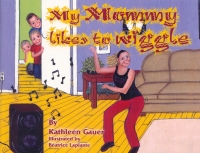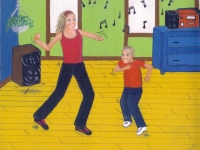| ________________
CM . . .
. Volume XX Number 21. . . .January 31, 2014 
 |
My Mommy Likes to Wiggle.
Kathleen Gauer. Illustrated by Béatrice Laplante.
Ottawa, ON: Baico, 2012.
26 pp., stapled, $25.00.
ISBN 978-1-926945-78-1.
Preschool-grade 1 / Ages 4-6.
Review by Janet Eastwood.
* /4
|
| |
|

excerpt:
Fast, slow, forward, back,
Line, circle, she’s right on track.
Belly Dance moves and Rumba perfection –
Better look quick, she’s changing direction.
She goes...
Wiggle, wiggle to the left; wiggle to the right,
Wiggle, wiggle, jiggle, jiggle –
Dancing through the night.
My Mommy Likes to Wiggle is an upbeat tale in rhyming verse about a mom who dances in the living room every evening. The boy narrator, who is not named, doesn’t understand the appeal of zumba. Eventually the mother’s obvious enjoyment draws the boy from watching her to dancing himself, and the whole family dances together.
The text font, playful and reminiscent of childish writing, fits the narrator neatly. Although this font may be difficult for young readers to decipher, this is a story that is more likely to be read by adults to children than by early readers, themselves, due to the vocabulary which includes the names of many dances, including long and likely unfamiliar words such as “flamenco” and “obsession”. The cover page font, on the other hand, is difficult to read and distracts from the colourful illustration.
The rhymes vary from wonderfully creative (disguise/exercise) to disappointing (Mambo/Tango, Mom/fun). Children will enjoy the repetition of “wiggle, wiggle” and “jiggle, jiggle” in the chorus. The rhythm of the four-line chorus changes after the second line, whereas the verses are (largely) more regular, but the chorus is catchy nonetheless.
The story requires some knowledge of dance names; however, a section at the end gives the basic background and characteristics of the Latin dances named as well as diagrams introducing a basic step from each dance. Rock and roll and hip-hop are not described in this end section, although young children are not likely to have much knowledge of these. Thus, this book could contribute to passing familiarity with a variety of dances if the parents and children read the notes at the end.
 The mom’s persistence in a hobby that brings her pleasure, despite her family’s lack of comprehension, is admirable, as is the message that stay-at-home moms deserve some time to themselves – and that their children can understand this. The book’s main problem is that it does not have a conflict. The mom keeps dancing, and her enthusiasm spreads to her entire family. The boy watches his mom and, self-consciously at first, begins dancing. There is little motivation given for his shift in attitude, and his justification for it seems out of place for his age. The boy at one point admits that his mom looks “cute” in her “tight and bright... workout suit,” which is odd coming from a boy who looks approximately 10-years-old.
The mom’s persistence in a hobby that brings her pleasure, despite her family’s lack of comprehension, is admirable, as is the message that stay-at-home moms deserve some time to themselves – and that their children can understand this. The book’s main problem is that it does not have a conflict. The mom keeps dancing, and her enthusiasm spreads to her entire family. The boy watches his mom and, self-consciously at first, begins dancing. There is little motivation given for his shift in attitude, and his justification for it seems out of place for his age. The boy at one point admits that his mom looks “cute” in her “tight and bright... workout suit,” which is odd coming from a boy who looks approximately 10-years-old.
It is difficult to determine who the main character is. The boy is the narrator, yet it is the mom who persists in doing what she chooses, much like the little boy in Ruth Krauss’ The Carrot Seed. The boy changes his mind during the story while the mom is described as having changed from dancing once or twice a week to dancing every night at a set time.
The mom is also the character who is depicted most often in the illustrations which give slightly more of the boy’s journey from giggling observer to active dancer than is found in the text. Otherwise, the illustrations tend to repeat the text in painted form. The most common facial expression is a toothy grin which remains in place for almost the entire story on every family member. The colours are cheerful and suit the upbeat, lively mood of the text.
The text does not give the narrator’s gender or ethnicity, nor does it mention a younger sibling. The illustrations depict the narrator as a young Caucasian boy and add a younger brother with the mom being the only female in the story. The mom seems to be strong-willed and persistent, and so it is particularly striking that she is made an object to be gazed at: all the males (husband and sons) look at her; the reader is invited to gaze at her, since she is the sole focal point for almost all the illustrations; and she always smiles, usually at the reader, but also at herself in a mirror. The fact that she smiles at her reflection is a good example of positive self-image, but her smile doesn’t vary from the one she wears for everyone else, which raises questions of how genuine it is.
Overall, although this book is cheerful, brightly coloured and introduces readers to a variety of Latin dance moves, it lacks a clear plot, conflict and protagonist.
Not Recommended.
Janet Eastwood is a student in the Master of Children’s Literature program at the University of British Columbia.

To comment
on this title or this review, send mail to cm@umanitoba.ca.
Copyright © the Manitoba Library Association. Reproduction for personal
use is permitted only if this copyright notice is maintained. Any
other reproduction is prohibited without permission.
NEXT REVIEW |
TABLE OF CONTENTS FOR THIS ISSUE
- January 31, 2013.
AUTHORS |
TITLES |
MEDIA REVIEWS |
PROFILES |
BACK ISSUES |
SEARCH |
CMARCHIVE |
HOME |

 The mom’s persistence in a hobby that brings her pleasure, despite her family’s lack of comprehension, is admirable, as is the message that stay-at-home moms deserve some time to themselves – and that their children can understand this. The book’s main problem is that it does not have a conflict. The mom keeps dancing, and her enthusiasm spreads to her entire family. The boy watches his mom and, self-consciously at first, begins dancing. There is little motivation given for his shift in attitude, and his justification for it seems out of place for his age. The boy at one point admits that his mom looks “cute” in her “tight and bright... workout suit,” which is odd coming from a boy who looks approximately 10-years-old.
The mom’s persistence in a hobby that brings her pleasure, despite her family’s lack of comprehension, is admirable, as is the message that stay-at-home moms deserve some time to themselves – and that their children can understand this. The book’s main problem is that it does not have a conflict. The mom keeps dancing, and her enthusiasm spreads to her entire family. The boy watches his mom and, self-consciously at first, begins dancing. There is little motivation given for his shift in attitude, and his justification for it seems out of place for his age. The boy at one point admits that his mom looks “cute” in her “tight and bright... workout suit,” which is odd coming from a boy who looks approximately 10-years-old.